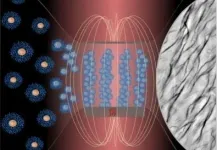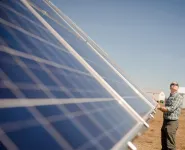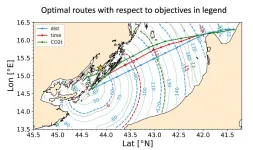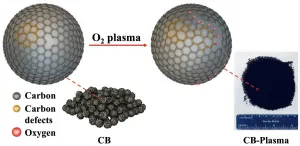(Press-News.org) Researchers at the University of Campinas's Chemistry Institute (IQ-UNICAMP) in the state of São Paulo, Brazil, have developed a template-free technique to fabricate cilia of different sizes that mimic biological functions and have multiple applications, from directing fluids in microchannels to loading material into a cell, for example. The highly flexible cilia are based on polymer-coated iron oxide nanoparticles, and their motion can be controlled by a magnet.
In nature, cilia are microscopic hairlike structures found in large numbers on the surface of certain cells, causing currents in the surrounding fluid or, in some protozoans and other small organisms, providing propulsion.
To fabricate the elongated nanostructures without using a template, Watson Loh and postdoctoral fellow Aline Grein-Iankovski coated particles of iron oxide (γ-Fe2O3, known as maghemite) with a layer of a polymer containing thermoresponsive phosphonic acid groups and custom-synthesized by a specialized company. The technique leverages the binding affinity of phosphonic acid groups to metal oxide surfaces, fabricating the cilia by means of temperature control and use of a magnetic field.
"The materials don't bind at room temperature or thereabouts, and form a clump without the stimulus of a magnetic field," Loh explained. "It's the effect of the magnetic field that gives them the elongated shape of a cilium."
Grein-Iankovski started with stable particles in solution and had the idea of obtaining the cilia during an attempt to aggregate the material. "I was preparing loose elongated filaments in solution and thought about changing the direction field," she recalled. "Instead of orienting them parallel to the glass slide, I placed them in a perpendicular position and found they then tended to migrate to the surface of the glass. I realized that if I forced them to stick to the glass, I could obtain a different type of material that wouldn't be loose: its movement would be ordered and collaborative."
The thermoresponsive polymer binds to the surface of the nanoparticles and organizes them into elongated filaments when the mixture is heated and exposed to a magnetic field. The transition occurs at a biologically compatible temperature (around 37 °C). The resulting magnetic cilia are "remarkably flexible", she added. By increasing the concentration of the nanoparticles, their length can be varied from 10 to 100 microns. One micron (μm) is a millionth of a meter.
"The advantage of not using a template is not being subject to the limitations of this method, such as size, for example," Grein-Inakovski explained. "In this case, to produce very small cilia we would have to create templates with microscopic holes, which would be extremely laborious. Adjustments to coat density and cilium size would require new templates. A different template has to be used for each end-product thickness. Furthermore, using a template adds another stage to the production of cilia, which is the fabrication of the template itself."
Grein-Iankovski is the lead author of an article published in The Journal of Physical Chemistry C on the invention, which was part of a Thematic Project supported by FAPESP, with Loh as principal investigator.
"The Thematic Project involves four groups who are investigating how molecules and particles are organized at the colloidal level, meaning at the level of very small structures. Our approach is to try to find ways of controlling these molecules so that they aggregate in response to an external stimulus, giving rise to different shapes with a range of different uses," Loh said.
Reversibility
After the magnetic field is removed, the material remains aggregated for at least 24 hours. It then disaggregates at a speed that depends on the temperature at which it was prepared. "The higher the temperature, the more intense the effect and the longer it remains aggregated outside the magnetic field," Grein-Iankovski said.
According to Loh, the reversibility of the material is a positive point. "In our view, being able to organize and disorganize the material, to 'switch the system on and off', is an advantage," Loh said. "We can adjust the temperature, how long it remains aggregated, cilium length, and coat density. We can customize the material for many different types of use, organize it and shape it for specific purposes. I believe the potential applications are countless, from biological to physical uses, including materials science applications."
Another major advantage, Grein-Iankovski added, is the possibility of manipulating the material externally, where the tool used to do so is not inside the system. "The filaments can be used to homogenize and move particles in a fluid microsystem, in microchannels, simply by approaching a magnet from the outside. They can be made to direct fluid in this way, for example."
The cilia can also be used in sensors, in which the particles respond to stimuli from a molecule, or to feed microscopic living organisms. "Ultimately it's possible to feed a microorganism or cell with loose cilia, which cross the cell membrane under certain conditions. They can be made to enter a cell, and a magnetic field is applied to manipulate their motion inside the cell," Loh said.
For more than ten years, Loh has collaborated with Jean-François Berret at Paris Diderot University (Paris 7, France) in research on the same family of polymers to obtain elongated materials for use in the biomedical field. "We're pursuing other partnerships to explore other possible uses of the cilia," he said.
The scientists now plan to include a chemical additive in the nanostructures that will bind the particles chemically, obtaining cilia with a higher mechanical strength that remain functional for longer when not exposed to a magnetic field, if this is desirable.
INFORMATION:
About São Paulo Research Foundation (FAPESP)
The São Paulo Research Foundation (FAPESP) is a public institution with the mission of supporting scientific research in all fields of knowledge by awarding scholarships, fellowships and grants to investigators linked with higher education and research institutions in the State of São Paulo, Brazil. FAPESP is aware that the very best research can only be done by working with the best researchers internationally. Therefore, it has established partnerships with funding agencies, higher education, private companies, and research organizations in other countries known for the quality of their research and has been encouraging scientists funded by its grants to further develop their international collaboration. You can learn more about FAPESP at http://www.fapesp.br/en and visit FAPESP news agency at http://www.agencia.fapesp.br/en to keep updated with the latest scientific breakthroughs FAPESP helps achieve through its many programs, awards and research centers. You may also subscribe to FAPESP news agency at http://agencia.fapesp.br/subscribe.
Photoplethysmography (PPG) is a simple optical technique used to detect volumetric changes in peripheral blood circulation. It's used in smart watches, for example, to monitor pulse and heart rate, but PPG biosensors are also found in millions of smartphones, but without any current clinical applications.
In a study published online in the February 2021 issue of Chest, researchers at University of California San Diego School of Medicine, with industry collaborators, found that already embedded PPG in smartphones, in tandem with application software, could be used for remote clinical pulse oximetry to manage chronic cardiopulmonary disease and perhaps initial treatment and monitoring of persons affected in respiratory viral pandemics, such as COVID-19.
"Pulse oximetry monitoring ...
As governments try to mitigate the spread of COVID-19, many are turning to contact tracing, including apps that track your location and electronic check-in QR codes. But with that technology come questions of personal safety, privacy, trust, control and collective action. So what can be done to improve these large-scale technological system roll-outs without infringing on a citizen's right to privacy?
"These systems are logging your physical social network," said Katina Michael, an Arizona State University professor at the School for the Future of Innovation in Society in the College of Global Futures and the School of Computing, Informatics and Decision Systems Engineering in the Ira A. Fulton Schools of Engineering. "The physical has become more ...
Beyond the environmental benefits and lower electric bills, it turns out installing solar panels on your house actually benefits your whole community. Value estimations for grid-tied photovoltaic systems prove solar panels are beneficial for utility companies and consumers alike.
For years some utility companies have worried that solar panels drive up electric costs for people without panels. Joshua Pearce, Richard Witte Endowed Professor of Materials Science and Engineering and professor of electrical and computer engineering at Michigan Technological University, has shown the opposite is true -- grid-tied solar photovoltaic (PV) owners are actually subsidizing their non-PV ...
ALBUQUERQUE, N.M. -- The huge forces generated by the Z machine at Sandia National Laboratories are being used to replicate the gravitational pressures on so-called "super-Earths" to determine which might maintain atmospheres that could support life.
Astronomers believe that super-Earths -- collections of rocks up to eight times larger than Earth -- exist in the millions in our galaxy. "The question before us is whether any of these super planets are actually Earthlike, with active geological processes, atmospheres and magnetic fields," said Sandia physicist Joshua Townsend.
The current ...
Energy efficiency or carbon intensity (defined as CO2 emissions per transport work, ed.) is a possible point of convergence between the International Maritime Organization (IMO) and EU regulations to cut GHG emissions and decarbonize shipping. Short term measures to increase energy efficiency and achieve carbon intensity savings include voyage optimization.
A new study led by the CMCC Foundation, realized in the framework of the Interreg Italy-Croatia END ...
New research by Morgan Philbin, PhD, at Columbia University Mailman School of Public Health and colleagues looks at why Black young men who have sex with men (YMSM) are disproportionately subject to high rates of arrest and incarceration. They find that perceived racial discrimination, sexual orientation discrimination, and HIV-status discrimination are all associated with risk for criminal justice involvement in this population.
The research appears in the journal Stigma and Health.
Various studies have shown that Black men are imprisoned at nearly seven times the rate of white men; sexual minority young adults are nearly three times more likely to report being criminally sanctioned compared to their heterosexual ...
An electrocardiogram (ECG) is an examination that records the electrical activity of the heart during the cardiac cycle. It is non-invasive and usually involves placing electrodes on the subject's skin. It is a most indicated type of examination when there is suspected heart disease and also in routine preventive health check-ups.
The cardiac cycle entails the emptying of blood from the atria to the ventricles ("P" wave, red in the image), the contraction of the ventricles to propel blood to the different tissues and organs of the body ("QRS" wave, green in the image), and ...
ATLANTA--ProAgio, a drug developed by Georgia State University biology professor Zhi-Ren Liu and his team, is effective at treating pancreatic cancer and prolonging survival in mice, according to a study published in the journal Cellular and Molecular Gastroenterology and Hepatology.
A second study, published in the Journal of Experimental Medicine, shows the drug is also effective against triple-negative breast cancer, a fast-growing and hard-to-treat type of breast cancer that carries a poor prognosis.
ProAgio, created from a human protein, targets the cell surface receptor integrin αVβ?, which is expressed on cancer-associated fibroblasts. Fibroblasts are cells ...
HOUSTON - (Feb. 9, 2021) - Rice University researchers have created a "defective" catalyst that simplifies the generation of hydrogen peroxide from oxygen.
Rice scientists treated metal-free carbon black, the inexpensive, powdered product of petroleum production, with oxygen plasma. The process introduces defects and oxygen-containing groups into the structure of the carbon particles, exposing more surface area for interactions.
When used as a catalyst, the defective particles known as CB-Plasma reduce oxygen to hydrogen peroxide with 100% Faradaic efficiency, a measure of charge transfer in electrochemical reactions. The process shows promise to replace the complex anthraquinone-based production ...
With the COVID-19 pandemic entering its second year, the challenges faced both by individuals and nations remain substantial. While notable medical advancements in the treatment of COVID-19 have been made, a host of questions about how to live with it and how to work to end it remain active.
Carnegie Mellon University researchers David Rode and Paul Fischbeck explore these questions in a new article, "On ambiguity reduction and the role of decision analysis during the pandemic," published in a special issue of the journal END ...




